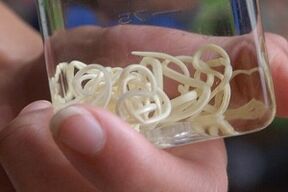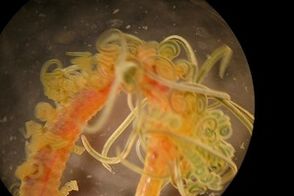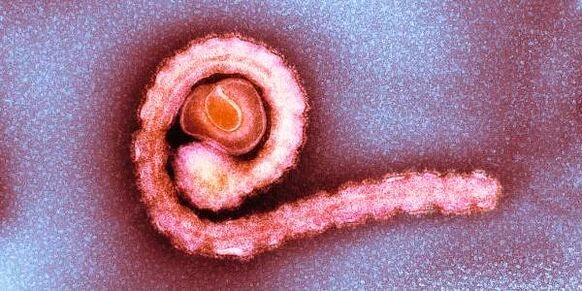
The history of helminthology dates back thousands of years.
The first documents describing parasites present in the human body, classified as roundworms according to modern classification, date back to the 6th century BC.
The term “helminths”, omnipresent today, was introduced by Hippocrates.
Since then, information on parasites has accumulated.
Today there are more than 100,000 species.
All this variety of helminths is classified as lower worms of the scolecida type (lat. Scolecida).
They are divided into four classes:
- flatworms are a class of cestodes (tapeworms) and trematodes (flukes);
- roundworms, which include a broad class of nematodes;
- spiny-headed worms;
- annelids.
The human body is parasitized by helminths of the first two types (more than 250 species in total).Helminths spend the main stages of their life cycle in the bodies of humans or animals, called hosts.
All parasites are divided into two large groups:
- geohelminths,their development begins in the external environment and ends in the tissues of the “host”;
- biohelminths,their vital activity occurs only in living organisms, and in the process of development, these worms can change several “hosts”.
There is also a group of so-called contagious helminths.These parasites present in the human body can be transmitted through close contact with an infected person;this type includes pinworms and dwarf tapeworms.
The most common nematous helminthic infestations are:

- ascariasis, caused by human roundworms;
- toxocariasis, which occurs when roundworms enter the intestines of animals;
- trichocephalosis, develops due to an infestation of whipworms;
- enterobiosis caused by pinworms;
- hookworm, their appearance is caused by the parasitism of the hookworm and the necator;
- strongylosis, its cause is intestinal acne;
- trichostrongylidosis caused by parasites of the same name;
- trichinosis caused by one of the four types of Trichinella;
- filariasis, their cause is filariae, also called filaments.
Among cestodiases, the following diseases are distinguished:
- diphyllobothriasis, causative agent - large tapeworm;
- teniarinhoz caused by bovine tapeworm;
- taeniasis or cysticercosis caused by the pork tapeworm;
- hymenolepidosis, causative agent - dwarf tapeworm;
- dipilidosis caused by canine tapeworm parasitism;
- echinococcosis, the cause of the disease is echinococcus or echinococcal tapeworm;
- alveococcosis, causative agent - alveococcus.
Among trematodes, the following helminthiases are often diagnosed:

- fascioliasis, causative agent - Fasciola vulgaris;
- opisthorchiasis, its cause is parasitism of the cat fluke;
- clonorchiasis caused by Chinese fluke;
- metagonimiasis, causative agent - metagonimus;
- schistosomiasis (genitourinary, intestinal, Japanese), caused by parasites of the same name.
A separate group includes the so-called protozoan diseases caused by the presence of unicellular protozoa: amoebae, malaria plasmodium, trypanosomes, lamblia, toxoplasma, trichomonas.
The average person has no idea how many pests they have to deal with every day.These microorganisms are present everywhere: in the ground, sandboxes, railings, common household items, toys, towels in swimming pools, baths and saunas, ponds, on the coat, paws and saliva of pets.However, the transformation of larvae and eggs into sexually mature individuals does not always occur.In the vast majority of cases, in the body of a healthy person, parasites die and are eliminated from the intestines.
However, in the tissues of children, people suffering from immunodeficiency, diseases of the digestive tract and endocrine system, worm larvae further transform into adult males and females.
Their life activity is accompanied by:
- metabolic disorders;
- vitamin deficiency;
- deficiency of minerals and proteins;
- the formation of an allergic response, which leads to the development of autoimmune processes;
- negative influence of toxic waste from helminths.
Additionally, almost all parasites mechanically damage various tissues at all stages of their life cycle.The larvae of many worms (strongyloides, schistosomes and others) when introduced into the body violate the integrity of the skin and mucous membranes.The dwarf tapeworm causes a change in the structure of the epithelium of the small intestine down to its deepest layers.With echinococcosis and alveococcosis, as the larvae grow, mechanical compression of the surrounding tissues, usually the liver, occurs, which leads to jaundice.

The gastrointestinal tract is actively washed by blood.Through its walls, worms penetrate into the main blood vessels and from there into almost all organs.The location of the main focus of development of the parasite determines the main symptoms of the disease.The penetration of helminths in one way or another affects the functioning of all organs and systems: immune, nervous, circulatory, digestive.
The severity of the lesion and clinical symptoms, the method of treatment depends on the type of parasite.Relatively “harmless” pinworms and roundworms in most cases cause disruption of the digestive tract.And the entry into the body of protozoa (for example, amoebae) can cause meningoencephalitis, pericardial pathologies and death.Parasites settle in the skin, organs of vision, brain and muscle tissue.
To eliminate some helminths, you can use folk remedies (pumpkin seeds, cleansing enemas with garlic and soda, taking infusions of celandine, ginger root, tansy and other medicinal plants).But in the presence of severe and massive infestations, herbs, homeopathic drops and herbal supplements cannot be used.To destroy the worms, long-term drug treatment is necessary and helps restore the basic functions of the digestive tract.
The development of helminthiasis can only be avoided by following certain preventive measures.
However, to prevent infection, it is necessary to know the main ways in which parasites appear in the human body:

- Orally, through hands, unwashed food, wool, feathers of domestic animals and birds, on which eggs and larvae of parasites as well as soil particles are present.This way you can become infected with ascariasis, enterobiasis and giardiasis.
- Xenotrophic when consumed as a food based on non-heat-treated meat, milk, fish and seafood.This route of transmission is typical of trichinosis and taeniasis.
- By contact, for example, through the pores of the skin, schistosomes enter the body (they live in warm climates).
- Transmitted through blood through insect bites (e.g. filariasis).
- Transplacental from mother to fetus, this is how toxoplasmosis is transmitted.
Taking into account the realities of modern domestic medicine, they try to postpone a visit to the doctor until the last minute, especially since drugs to get rid of helminthiasis can be purchased without a prescription in any pharmacy.But everything is not as simple as it seems at first glance.The means of combating parasites are not the same in their therapeutic activity;in addition, different types of worms “require” individual selection of dosage and duration of treatment.
Therefore, if you suspect the presence of parasites in the human body, you should contact a specialist.The algorithm of its actions is as follows:
- examination of the patient and collection of the history (for example, recent return from exotic countries requires special studies to identify the pest);
- appointment for a general blood test, stool test, coprogram;
- blood tests for the presence of specific antibodies, this analysis will accurately determine the causative agent of the disease;
- assessment of the condition of internal organs, the presence of abscesses, ulcers and necrotic areas caused by parasites;
- identification of possible concomitant diseases that may constitute contraindications to the prescription of certain medications.
It's important!
Self-treatment of helminthic infestations is contraindicated during pregnancy and breastfeeding.
Signs of parasites in the body depending on the site of localization
Tissue damage caused by helminths is accompanied by numerous point hemorrhages.This causes anemia, weakness, fatigue and decreased performance.Due to the disruption of metabolic processes and the absorption of vitamins and minerals, the condition of the skin, nails and hair deteriorates.A person quickly loses weight and frequently suffers from viral and infectious diseases.

In addition, the vital activity of most pathogenic microorganisms occurs with the release of toxins.The immune system reacts accordingly to their appearance, so if there are parasites in the human body, the symptoms of an allergic reaction will certainly be present.Clinical signs of general intoxication also develop, which manifest themselves in the form of malaise, irritability, insomnia, nervous disorders and deterioration in well-being.
The development of parasitic invasion into the tissues of the human heart occurs against the background of severe disturbances in the functioning of the myocardium.
Patients complain of:
- shortness of breath;
- change in heart rate;
- feeling of lack of air;
- feeling of discomfort and heaviness in the chest.
The addition of an inflammatory process can cause pericarditis or myocarditis.These diseases are accompanied by an increase in body temperature and severe pain in the heart area.
Epidermal helminthiasis is relatively rare.As a rule, they develop against the background of damage to the intestines and other internal organs.
Signs of parasites in the body when certain worms invade the skin may look like this:

- ulcerations in areas of contact with feces;
- the appearance of an itchy rash;
- swelling and redness, sometimes during the migration of helminths;
- the formation of swellings that resemble wen in appearance;
- the appearance of purulent acne.
The symptoms of parasites entering the eye depend on several factors.If the helminth “lives” under the skin of the eyelid, its movements can be felt or even seen.However, when the worms penetrate deeper into the optic nervous system, there is a risk of strabismus, significant visual impairment, and limited visibility.Without proper treatment, the development of ocular helminthiasis can lead to irreversible blindness.
The gastrointestinal tract is the habitat of the vast majority of helminths.This is why, if parasites appear in the human body, the symptoms mainly come from the digestive system.
The patient generally complains of:
- pain of varying intensity and discomfort in the abdominal region;
- diarrhea, which can be replaced by constipation, is especially typical in the early stages of infection;
- mixture of mucus and blood in stools;
- the appearance of painful spasms simultaneously with the urge to defecate;
- decreased or lack of appetite;
- flatulence, bloating.
Due to dysfunction of the digestive glands, a person constantly feels heaviness in the stomach.In some cases, a ball of roundworms can cause intestinal obstruction.
The penetration of worms into the hematopoietic system is accompanied by disturbances throughout the body.Moreover, such an invasion sometimes does not manifest itself in the form of external symptoms.However, due to the destruction of red blood cells and other formed elements, frequent headaches, dizziness and drowsiness occur, despite compliance with the daily routine, constant weakness and intolerance to physical activity.
In addition, signs of parasites in the body in the circulatory system are accompanied by enlargement of lymph nodes and exacerbation of chronic diseases.The size of the liver and spleen increases, and body temperature often increases.
Doctors stress that the discovery of a foreign “creature” in the body should not be a cause for panic.Modern drugs make it possible to quickly and without side effects clean all organs from helminths and completely restore their functioning.
Human parasites: treatment and prevention methods
Relatively recently, some private clinics announced that a new safe method has been created to combat worms: bioresonance therapy.The principle of this treatment is based on the laws of physics.According to the theory of the developers of this method, each cell of our body is not stationary in one place, but is in a mode of constant vibration, emitting electromagnetic waves.Their length is individual for each internal organ.
Human parasites are no exception, but the resonance of their movements is different from that of our body's tissues.During a bioresonance therapy session, metal electrodes are applied to certain biologically active points.They send waves of a given length, which do not affect the functioning of a person's own cells, but destroy the bodies of parasites.

The benefits of bioresonance therapy include safety and painlessness.However, the clinical effectiveness of this treatment method has not been proven, and the treatment equipment does not have appropriate certificates.But exposure to electromagnetic waves will not cause any harm or cause complications.
In reality, there are not many medications used to get rid of helminths and protozoa.The dosage of drugs, their treatment regimen and duration of use are selected by the doctor depending on the patient's age, the severity of the invasion and the presence of concomitant pathologies.
For relatively mild helminthic infestations, it is recommended to use traditional medicine recipes.These products can be easily prepared at home, and the components are sold at any pharmacy.
To expel helminths from the intestines, healers recommend:
- Consume as much onion, garlic, ginger and pomegranate as possible.
- Buy regular cloves, which are used in cooking.It is ground in a coffee grinder and taken according to the following scheme: on the first day 0.5 g, on the second - 1 g, and on the third to ninth - 1.5 g in the morning on an empty stomach.
- Pour a tablespoon of crushed and dried nettle roots into a glass of boiling water and simmer in a water bath for 15 minutes.Let cool completely and take 3 tbsp.L.three times a day before meals.
- Mix aloe and onion juice in equal proportions, add honey and take one tablespoon 3 times a day for several weeks.
- Mix 10 tbsp.L.flax seeds and 1 tbsp.L.cloves, grind and take at the rate of 2.5 g of powder per 1 kg of body weight.
- Mix the grated coconut pulp and coconut milk.Use this mixture 1 tbsp.three times a day on an empty stomach.
Almost the only method to prevent the appearance of human parasites in the intestines and other tissues is strict adherence to the rules of hygiene, known to everyone from early childhood.This involves washing your hands before eating, after going to the toilet and after returning from a walk.Careful heat treatment of drinking water, milk, meat, fish and cleaning of fresh fruits and vegetables from contaminants are also necessary.
But human parasites appear at every stage, so it is almost impossible to avoid encountering them.To prevent serious complications of invasion, it is necessary to strengthen the immune system and monitor the condition of the digestive tract.As soon as the first symptoms of helminthiasis appear, you should consult a doctor, take the prescribed tests and undergo the full course of treatment with obligatory monitoring of its effectiveness.
















































